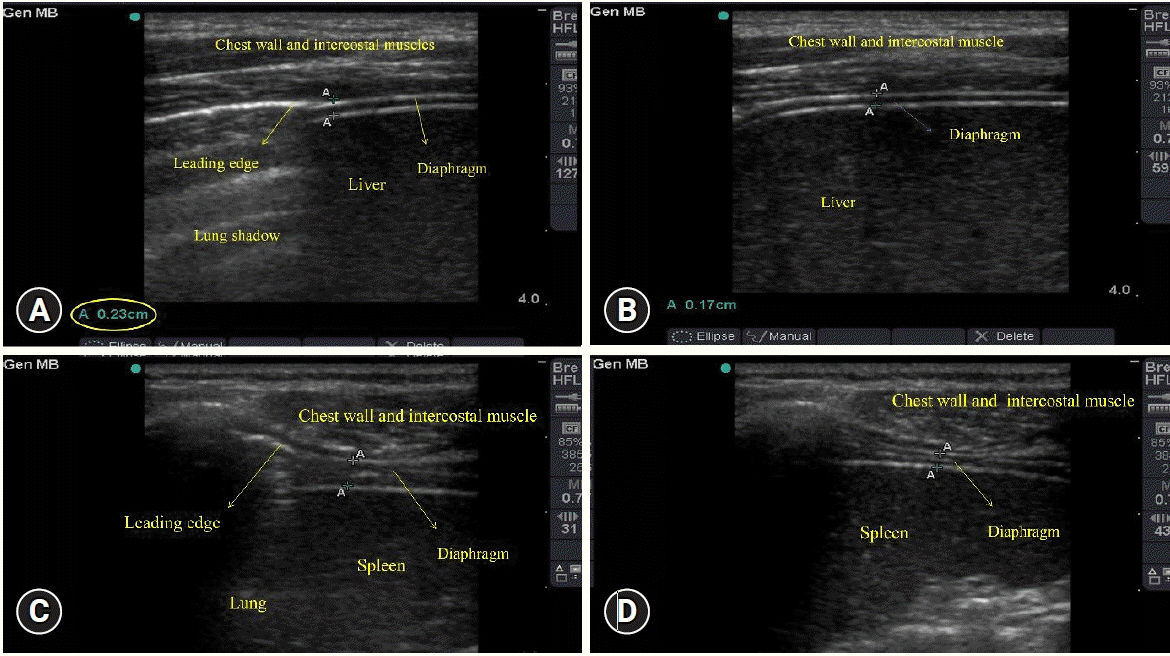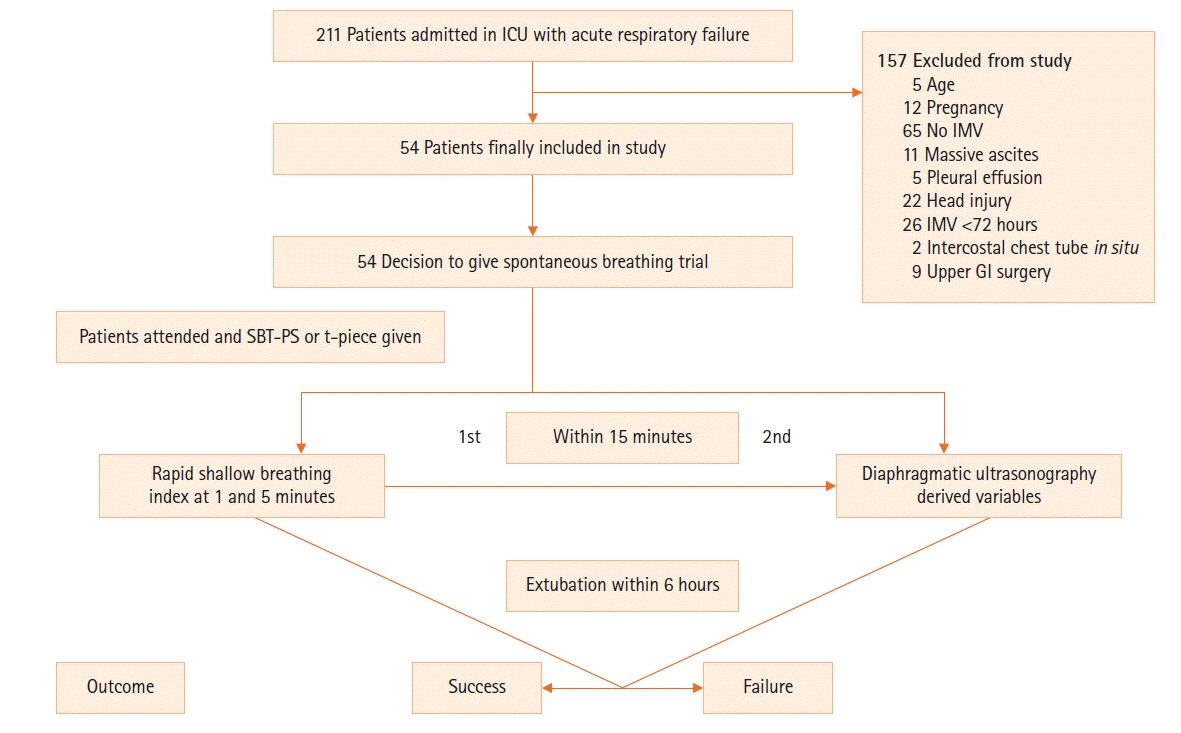Acute Crit Care.
2022 Aug;37(3):347-354. 10.4266/acc.2022.00108.
The role of diaphragmatic thickness measurement in weaning prediction and its comparison with rapid shallow breathing index: a single-center experience
- Affiliations
-
- 1Department of Tuberculosis and Respiratory Medicine, Post Graduate Institute of Medical Sciences, Rohtak, India
- 2Department of Pulmonary and Critical Care Medicine, Post Graduate Institute of Medical Sciences, Rohtak, India
- 3Chest and Bronchoscopy Centre, Agra, India
- KMID: 2535298
- DOI: http://doi.org/10.4266/acc.2022.00108
Abstract
- Background
Acute respiratory failure (ARF) is commonly managed with invasive mechanical ventilation (IMV). The majority of the time that a patient spends on IMV is in the process of weaning. Prediction of the weaning outcome is of paramount importance, as untimely/delayed extubation is associated with a high risk of mortality. Diaphragmatic ultrasonography is a promising tool in the intensive care unit, and its utility in predicting the success of weaning remains understudied.
Methods
In this prospective-observational study, we recruited 54 ARF patients on IMV, along with 50 healthy controls. During a spontaneous breathing trial, all subjects underwent diaphragmatic ultrasonography along with a rapid shallow breathing index (RSBI) assessment.
Results
The mean age was 41.8±17.0 and 37.6±10.5 years among the cases and control group, respectively. Demographic variables were broadly similar in the two groups. The most common cause of ARF was obstructive airway disease. The average duration of IMV was 5.41±2.81 days. Out of 54 subjects, 45 were successfully weaned, while nine patients failed weaning. Age, body mass index, and severity of disease were similar in the successful and failed weaning patients. The sensitivity in predicting successful weaning of percent change in diaphragmatic thickness (Δtdi%) >29.71% was high (93.33%), while specificity was 66.67%. The sensitivity and specificity of mean diaphragmatic thickness (tdi) end-expiratory >0.178 cm was 60.00% and 77.78%, respectively. RSBI at 1 minute of <93.75 had an equally high sensitivity (93.33%) but a lower specificity (22.22%). Similar results were also found for RSBI measured at 5 minutes.
Conclusions
During the weaning assessment, the purpose is to minimize both premature as well as delayed extubation. We found that diaphragmatic ultrasonography, in particular Δtdi%, is better than RSBI in predicting weaning outcomes.
Keyword
Figure
Reference
-
1. Jabaley CS, Groff RF, Sharifpour M, Raikhelkar JK, Blum JM. Modes of mechanical ventilation vary between hospitals and intensive care units within a university healthcare system: a retrospective observational study. BMC Res Notes. 2018; 11:425.2. Stroetz RW, Hubmayr RD. Tidal volume maintenance during weaning with pressure support. Am J Respir Crit Care Med. 1995; 152:1034–40.3. Jubran A, Tobin MJ. Pathophysiologic basis of acute respiratory distress in patients who fail a trial of weaning from mechanical ventilation. Am J Respir Crit Care Med. 1997; 155:906–15.4. Vassilakopoulos T, Zakynthinos S, Roussos C. The tension-time index and the frequency/tidal volume ratio are the major pathophysiologic determinants of weaning failure and success. Am J Respir Crit Care Med. 1998; 158:378–85.5. Roussos C. Ventilatory muscle fatigue governs breathing frequency. Bull Eur Physiopathol Respir. 1984; 20:445–51.6. Jacob B, Chatila W, Manthous CA. The unassisted respiratory rate/tidal volume ratio accurately predicts weaning outcome in postoperative patients. Crit Care Med. 1997; 25:253–7.7. Mohsenifar Z, Hay A, Hay J, Lewis MI, Koerner SK. Gastric intramural pH as a predictor of success or failure in weaning patients from mechanical ventilation. Ann Intern Med. 1993; 119:794–8.8. Houston JG, Morris AD, Grosset DG, Lees KR, McMillan N, Bone I. Ultrasonic evaluation of movement of the diaphragm after acute cerebral infarction. J Neurol Neurosurg Psychiatry. 1995; 58:738–41.9. Gerscovich EO, Cronan M, McGahan JP, Jain K, Jones CD, McDonald C. Ultrasonographic evaluation of diaphragmatic motion. J Ultrasound Med. 2001; 20:597–604.10. Sarwal A, Walker FO, Cartwright MS. Neuromuscular ultrasound for evaluation of the diaphragm. Muscle Nerve. 2013; 47:319–29.11. Miller SG, Brook MM, Tacy TA. Reliability of two-dimensional echocardiography in the assessment of clinically significant abnormal hemidiaphragm motion in pediatric cardiothoracic patients: comparison with fluoroscopy. Pediatr Crit Care Med. 2006; 7:441–4.12. Summerhill EM, El-Sameed YA, Glidden TJ, McCool FD. Monitoring recovery from diaphragm paralysis with ultrasound. Chest. 2008; 133:737–43.13. DiNino E, Gartman EJ, Sethi JM, McCool FD. Diaphragm ultrasound as a predictor of successful extubation from mechanical ventilation. Thorax. 2014; 69:423–7.14. Ferrari G, De Filippi G, Elia F, Panero F, Volpicelli G, Aprà F. Diaphragm ultrasound as a new index of discontinuation from mechanical ventilation. Crit Ultrasound J. 2014; 6:8.15. Bhatt K, Agolli A, Patel MH, Garimella R, Devi M, Garcia E, et al. High mortality co-infections of COVID-19 patients: mucormycosis and other fungal infections. Discoveries (Craiova). 2021; 9:e126.
Article16. Samanta S, Singh RK, Baronia AK, Poddar B, Azim A, Gurjar M. Diaphragm thickening fraction to predict weaning: a prospective exploratory study. J Intensive Care. 2017; 5:62.17. Boussuges A, Rives S, Finance J, Brégeon F. Assessment of diaphragmatic function by ultrasonography: current approach and perspectives. World J Clin Cases. 2020; 8:2408–24.
Article18. Tobin MJ, Yang K. Weaning from mechanical ventilation. Crit Care Clin. 1990; 6:725–47.
Article19. Cohen JD, Shapiro M, Grozovski E, Lev S, Fisher H, Singer P. Extubation outcome following a spontaneous breathing trial with automatic tube compensation versus continuous positive airway pressure. Crit Care Med. 2006; 34:682–6.
Article20. Wilson AM, Gray DM, Thomas JG. Increases in endotracheal tube resistance are unpredictable relative to duration of intubation. Chest. 2009; 136:1006–13.
Article21. Banerjee A, Mehrotra G. Comparison of lung ultrasound-based weaning indices with rapid shallow breathing index: are they helpful? Indian J Crit Care Med. 2018; 22:435–40.
Article22. Francis CA, Hoffer JA, Reynolds S. Ultrasonographic evaluation of diaphragm thickness during mechanical ventilation in intensive care patients. Am J Crit Care. 2016; 25:e1–8.
Article23. Kawar E, DiNino E, Gartman E, Sethi J, McCool FD. Diaphragm thickening predicts weaning from mechanical ventilation. Am J Respir Crit Care Med. 2012; 185:A2723–8.
Article24. Farghaly S, Hasan AA. Diaphragm ultrasound as a new method to predict extubation outcome in mechanically ventilated patients. Aust Crit Care. 2017; 30:37–43.
Article25. Alam MJ, Roy S, Iktidar MA, Padma FK, Nipun KI, Chowdhury S, et al. Diaphragm ultrasound as a better predictor of successful extubation from mechanical ventilation than rapid shallow breathing index. Acute Crit Care. 2022; 37:94–100.
Article26. Yang KL, Tobin MJ. A prospective study of indexes predicting the outcome of trials of weaning from mechanical ventilation. N Engl J Med. 1991; 324:1445–50.
Article27. Goligher EC, Fan E, Herridge MS, Murray A, Vorona S, Brace D, et al. Evolution of diaphragm thickness during mechanical ventilation: impact of inspiratory effort. Am J Respir Crit Care Med. 2015; 192:1080–8.
Article28. Grosu HB, Lee YI, Lee J, Eden E, Eikermann M, Rose KM. Diaphragm muscle thinning in patients who are mechanically ventilated. Chest. 2012; 142:1455–60.
Article29. Daley BJ, Garcia-Perez F, Ross SE. Reintubation as an outcome predictor in trauma patients. Chest. 1996; 110:1577–80.
Article30. Pirompanich P, Romsaiyut S. Use of diaphragm thickening fraction combined with rapid shallow breathing index for predicting success of weaning from mechanical ventilator in medical patients. J Intensive Care. 2018; 6:6.
Article
- Full Text Links
- Actions
-
Cited
- CITED
-
- Close
- Share
- Similar articles
-
- Weaning Approach with Weaning Index for Postoperative Patients with Mechanical Ventilator Support in the ICU
- Role of Bedside Ultrasonography in Assessment of Diaphragm Function as a Predictor of Success of Weaning in Mechanically Ventilated Patients
- Diaphragm ultrasound as a better predictor of successful extubation from mechanical ventilation than rapid shallow breathing index
- Predicting Delayed Ventilator Weaning after Lung Transplantation: The Role of Body Mass Index
- Transitional Percentage of Minute Volume as a Novel Predictor of Weaning from Mechanical Ventilation in Patients with Chronic Respiratory Failure



